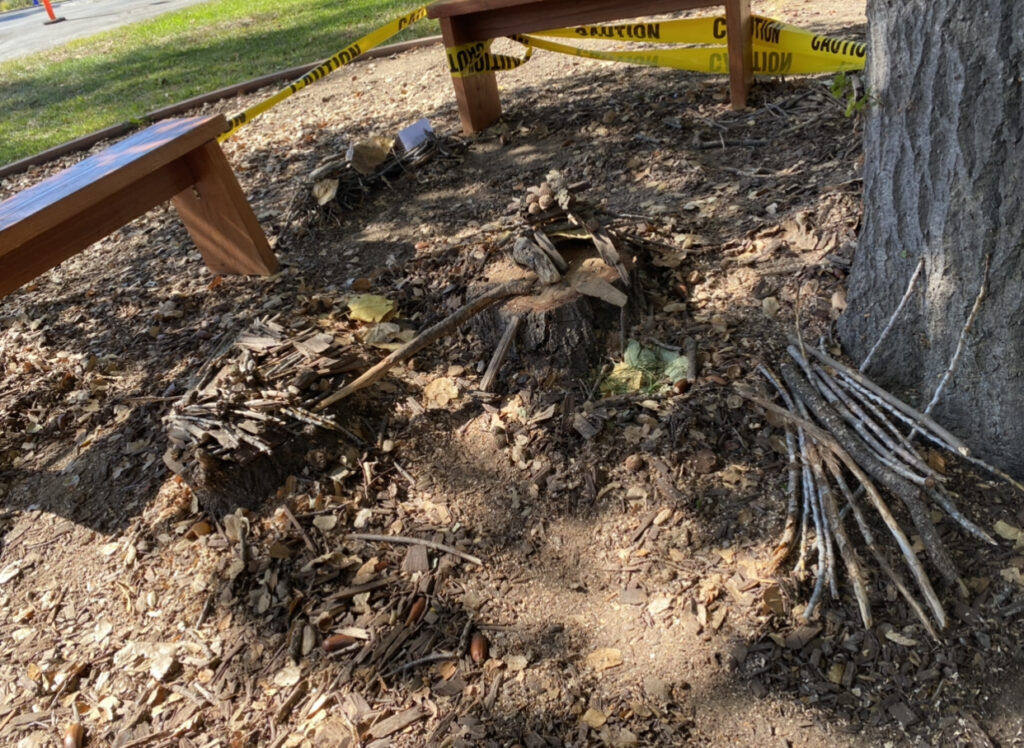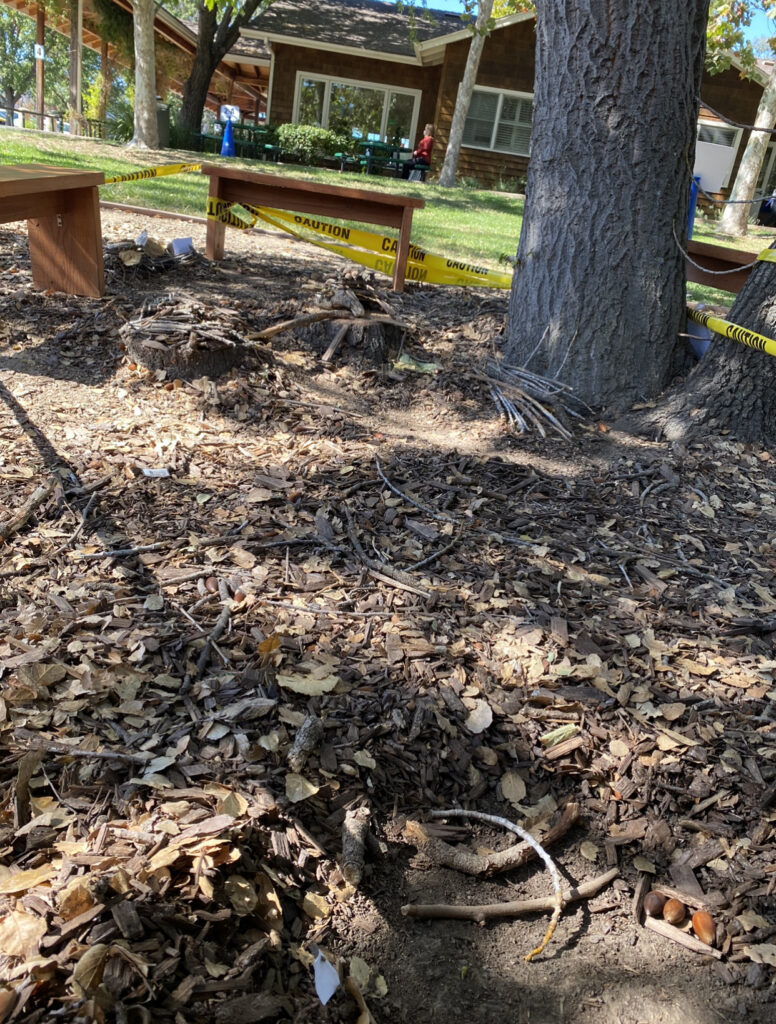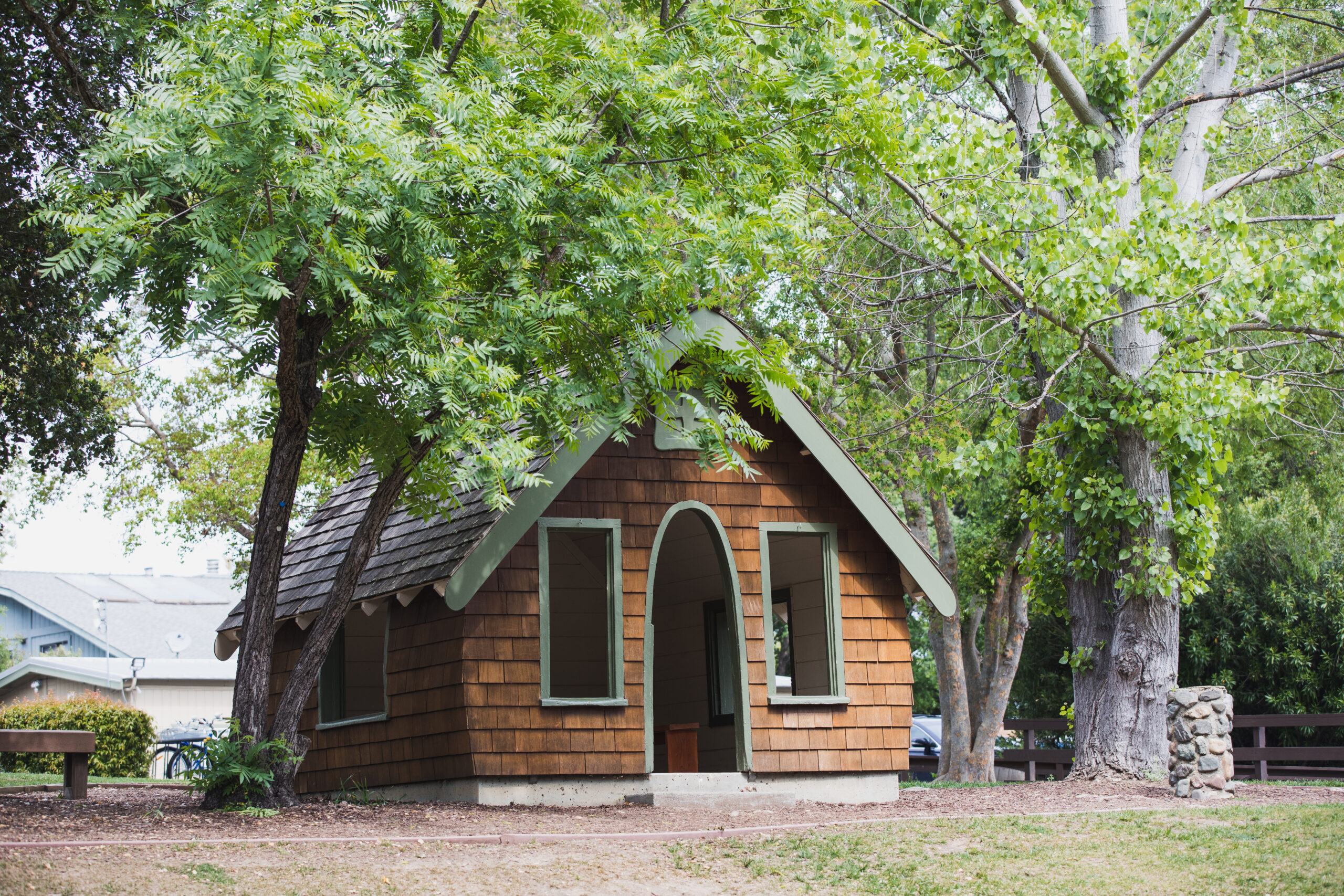
“Mr. Silver, Mr. Silver, Mr. Silver!” A group of 3rd graders yelled out to me as I was walking up the hill. They were playing up near the top of the Village of Friendly Relations, one of the new outdoor play spaces assigned to stable cohorts in order to ensure physical distancing on campus. I walked close enough so that I could see what they wanted to show me, a pile of sticks, rocks, acorns, bark, and other natural items scavenged from campus and carefully constructed into a “fairy village”. They enthusiastically described for me the different parts of the village – a soup diner with full bowls of acorn soup, a rain shelter, and, of course, electrical wiring to ensure lighting at night. They also pointed out the science lab, a portion of a tree that had what the student described as “an unknown black material” on it that the fairies could study. Lower School science teacher Lara Blom would have been proud!
It was a quintessential Hillbrook moment and, if not for the masks and our collective efforts to remain physically separate from each other, felt like hundreds of other moments I have had in my many years at the school. It was a little bit of Hillbrook magic – the connection with nature, the opportunity to use your imagination, the celebration of childhood.
It was also a moment that filled my need – and the childrens’ need – for connection with other people. Creating connection is one of Hillbrook’s greatest strengths, and yet it is so much harder to do during the pandemic. Amidst the many barriers we must follow in order to ensure our collective health and safety – stable groups, mask wearing, physical distancing, limited access to campus, distance learning – finding moments of real and meaningful connection has never been more challenging.
I have had many conversations with adults this year about how we might do this. And yet, perhaps not surprisingly, one of the most meaningful conversations I had about this topic took place with a group of our students. Last Friday, I had the privilege of interviewing four 8th grade students and two 8th grade teachers, Associate Director of the Scott Center Matt Callahan and Secondary School Counselor Eden Maisel, to learn more about a podcast they are producing as part of their class, Social Impact & Leadership. The podcast was created in response to the provocation – “How do we connect over time and space with our peers?” – a provocation that speaks to the particular challenges students are feeling at this moment. The class designed the podcast as an opportunity to talk with students at Hillbrook and around the world about how they are managing through this moment, as well as create a shared experience for the group by having something everyone could listen to together. The students interviewed peers from as far away as Chicago and Finland, asking them to describe the world they are living in and, in particular, what it was like to be in school. In these brief conversations they were able to find moments of connection, seeing how things are similar or different for their peers on campus and around the world. I encourage you to listen to the first two episodes of their podcast, Perspectives, as well as future episodes which will appear in the weeks ahead.

As I was talking with the 8th grade students, I was struck by how grateful they are for the high quality experience their teachers are providing. Whether participating in-person or in our distance learning mode, the students talked about how “amazing” the teachers are, noting how hard they are working to “make our 8th grade year enjoyable” and “to make it so we have the best possible experience.” As one student aptly noted, “teaching Middle Schoolers in a normal world is already not easy, they are taking a hard job and making it even harder.” And, she noted, despite that, they are doing it incredibly well.
I was also struck by how powerful the experience of creating the podcast was for these students. The podcast is a powerful example of what education can be – an authentic collaboration between students to create a product that is intended for a real audience beyond just the teacher. Talking to the students, they remarked about how much they enjoyed the process, and how it allowed each of them to leverage their strengths. Students could be researchers, writers, interviewers, production editors, and graphic artists. Students were required to bring together a whole range of academic skills – research, writing, public speaking, critical thinking – as well as important skills in collaboration, time and project management, and group problem solving.
It also created a space for creativity and imagination, or, as one student put it, “creative liberty.” As she noted, “I had a really positive experience working with the group. I felt like we had a lot of creative liberty and we were able to make our podcast how we wanted our podcast to be. Often things are really structured and it’s hard to be creative in your own way, this was a really great way to get to make our own creation.”
Their podcast, in turn, inspired me to try to do something similar for the Hillbrook community, namely, find ways for me to connect people to life on campus. With daily access limited to students, I thought – how might we offer families a glimpse into what is happening through the eyes of students and teachers?
So, I decided to use my podcast, Remarks & Reflections, as a way to share stories with families about how different members of our community are experiencing this school year. The first episode was my conversation with the students from Social Impact & Leadership. After all, they are the ones who provided me the inspiration to pursue this topic. You can check out the full episode – “Riding the Rollercoaster” – here. Future episodes will focus on other grade levels and teaching teams, as well as, I hope, at least one episode in which I have a chance to hear from parents and how they are navigating through this year.
Unlike so much of what happens in traditional educational settings, these stories of student-generated creation are not measured with a teachers’ grade or comment. The outcome is measured in the quality of the production (whether a fairy village or a podcast), the response of the audience, and the connection students are able to make with peers and adults on campus and around the world. Want to be inspired by what Hillbrook students are capable of doing? Listen to their stories about how they are transforming a school experience characterized by new limitations into something connective, generative…even magical. It gives you a small glimpse into how these students are being prepared to change the world.

